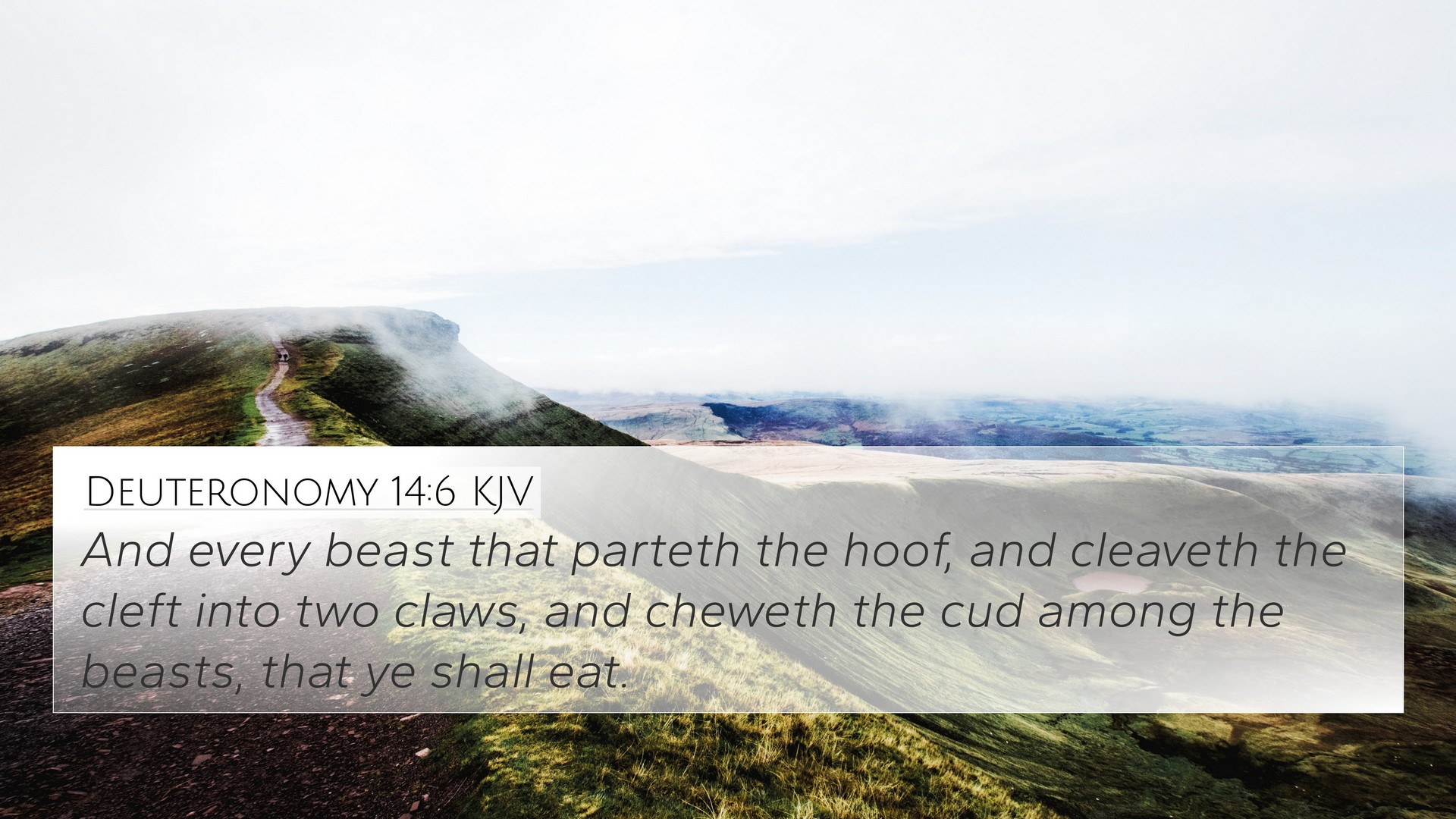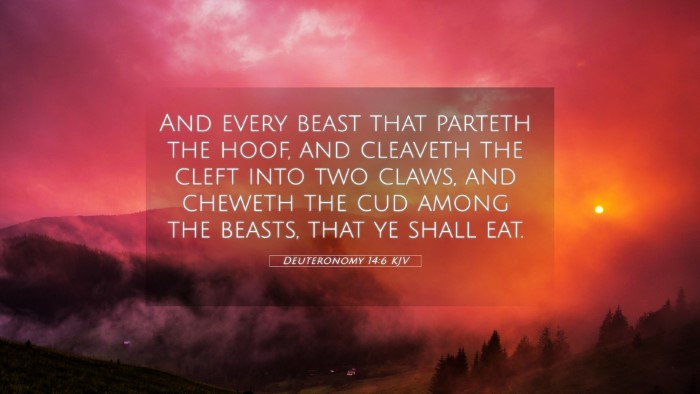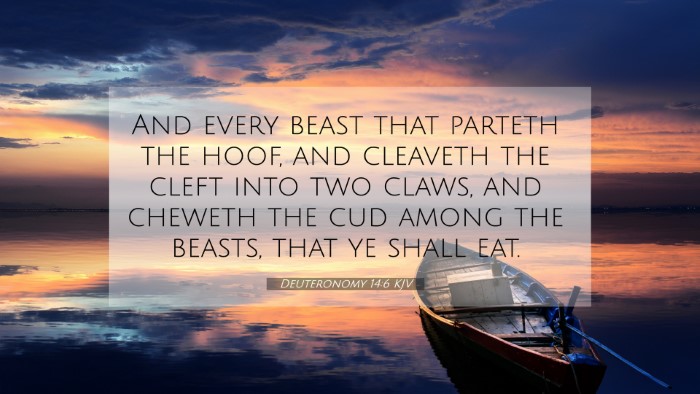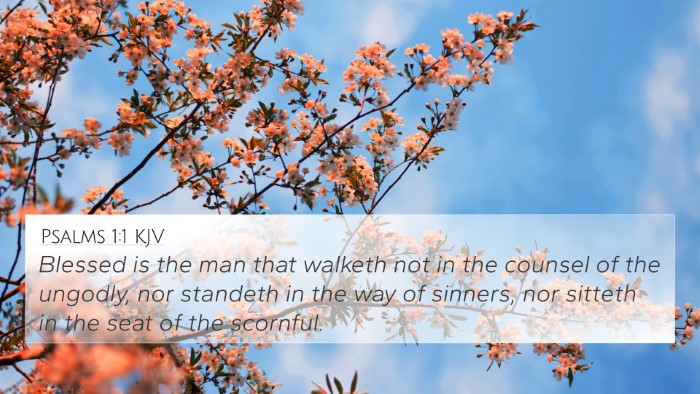Understanding Deuteronomy 14:6
Verse: "And every beast which parteth the hoof, and cleaveth the cleft into two claws, and cheweth the cud among the beasts, that shall ye eat." (Deuteronomy 14:6)
Overview of the Verse
Deuteronomy 14:6 addresses dietary laws for the Israelites, specifying which animals are considered clean and permissible for consumption. This verse is part of the larger context of the Levitical dietary restrictions that aim to set the Israelites apart from other nations.
Key Themes and Insights
- Cultural Separation: The dietary laws underscore the importance of holiness and separation from pagan practices, a recurring theme throughout the Pentateuch.
- Ritual Purity: The categorization of clean and unclean animals emphasizes the notion of ritual purity which is foundational in the ancient Israelite religion.
- Symbolism of Clean Animals: The characteristics required for animals to be deemed clean (such as chewing the cud) symbolize a deeper spiritual truth; for example, meditation on God’s word.
Commentary Insights
Matthew Henry’s Commentary
Matthew Henry explains that the distinction between clean and unclean animals serves to instruct the people in the holiness required of them. He emphasizes that God’s people are called not just to obey laws, but to understand their symbolic meanings. He highlights the importance of discerning what is clean and unclean in both the dietary law and in spiritual matters.
Albert Barnes’ Commentary
Albert Barnes discusses the practical aspects of this law for the Israelites. He notes that these regulations were not only for dietary health but also for maintaining the cultural identity of Israel. Barnes suggests that understanding these laws can lead to deeper connections in one’s faith and understanding of God’s intentions.
Adam Clarke’s Commentary
Adam Clarke provides an analysis of the specifics of the animals referenced in the verse. He notes the necessity for believers to adhere to these laws as they reflect the character of God himself. Clarke points to the significance of these regulations in maintaining a distinct community that honors God’s commandments.
Cross-References and Thematic Connections
Deuteronomy 14:6 connects deeply with several other scriptures, both within the Old Testament and the New Testament. Here are some relevant cross-references:
- Leviticus 11:3-8 - Details on clean and unclean animals.
- Isaiah 65:4 - Critique of unclean practices among the people.
- Matthew 15:11 - Jesus’ teaching on what defiles a person.
- Acts 10:12-14 - Peter’s vision concerning clean and unclean animals.
- 1 Timothy 4:4-5 - New Testament perspective on dietary laws.
- Hebrews 9:9 - Reference to the symbolism of the dietary laws in relation to the old covenant.
- Romans 14:14 - Discussion on dietary practices within the early church.
- Galatians 5:1 - Freedom from the law and its implications on dietary restrictions.
Conclusion
Deuteronomy 14:6 serves as a vital instruction within the scriptures for understanding God’s expectations from His people, as well as the importance of maintaining a unique identity as His chosen ones. By studying this verse and its connections within the larger narrative of scripture, one gains better insight into the nature of God's holiness and His desire for His followers to reflect that holiness in every aspect of their lives.
Exploring Deeper Connections
For those seeking deeper learning, employing tools for Bible cross-referencing can enhance your understanding, revealing the intricate web of connections between verses. Resources like a Bible concordance or a cross-reference Bible study guide can provide insights on how different verses support or relate to one another. This method also aids in thematic Bible verse connections, where one can identify overarching concepts across both the Old and New Testaments.
Call to Action
Consider using these insights for sermon preparation or personal study. Understanding the connections between Bible verses can enrich your faith experience and provide clarity in interpreting Biblical themes. Engage actively with Scripture, and utilize cross-referencing methods to deepen your exploration of God’s Word.





